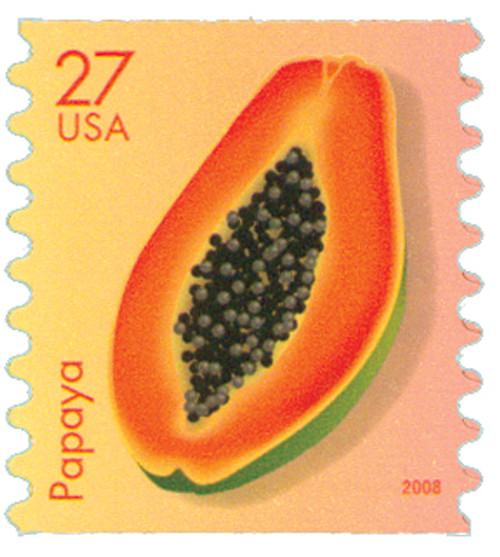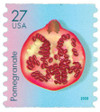
# 4260 - 2008 27c Tropical Fruit: Pomegranate,coil
Tropical Fruit
Pomegranate
Die Cut 8.5
Issue Date: April 25, 2008
City: Burlingame, CA
The pomegranate (Punica granatum) is native to the area from Afghanistan, Pakistan, and Iran to the Himalayas in northern India. It has also been cultivated in the Mediterranean, Armenia, Southeast Asia, Malaysia, tropical Africa, Latin America, Arizona, and California.
The fruit gets its name from the Latin term pomum granatus, or “seeded apple.” The pomegranate’s genus, Punica, is named after the Phoenicians, who were largely responsible for expanding its cultivation.
Pomegranates grow best in dry areas with moderate summer rainfall. They can normally survive droughts and can tolerate moderate frosts down to approximately 14 degrees Fahrenheit. The flowers of the pomegranate tree are bright red with four to five small petals. The fruit, ranging in size from two to five inches in diameter, has a round hexagonal shape. The pomegranate’s thick red skin is filled with around 600 edible seeds (known as arils) and pulp. The red seeds and white to deep-red pulp give the fruit a flavor that ranges from very sweet to very sour, depending on its ripeness.
Emerging research suggests that the juice of the pomegranate can reduce the risk of heart disease.
In 2008, the pomegranate was part of a set of Tropical Fruit stamps issued by the United States Postal Service.
Tropical Fruit
Pomegranate
Die Cut 8.5
Issue Date: April 25, 2008
City: Burlingame, CA
The pomegranate (Punica granatum) is native to the area from Afghanistan, Pakistan, and Iran to the Himalayas in northern India. It has also been cultivated in the Mediterranean, Armenia, Southeast Asia, Malaysia, tropical Africa, Latin America, Arizona, and California.
The fruit gets its name from the Latin term pomum granatus, or “seeded apple.” The pomegranate’s genus, Punica, is named after the Phoenicians, who were largely responsible for expanding its cultivation.
Pomegranates grow best in dry areas with moderate summer rainfall. They can normally survive droughts and can tolerate moderate frosts down to approximately 14 degrees Fahrenheit. The flowers of the pomegranate tree are bright red with four to five small petals. The fruit, ranging in size from two to five inches in diameter, has a round hexagonal shape. The pomegranate’s thick red skin is filled with around 600 edible seeds (known as arils) and pulp. The red seeds and white to deep-red pulp give the fruit a flavor that ranges from very sweet to very sour, depending on its ripeness.
Emerging research suggests that the juice of the pomegranate can reduce the risk of heart disease.
In 2008, the pomegranate was part of a set of Tropical Fruit stamps issued by the United States Postal Service.










